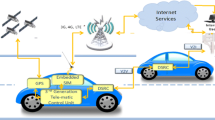Abstract
In this paper, we show experimentally the feasibility of intervehicle communication of warning information. Warning messages convey significant information that might improve the safety of drivers and passengers. Intervehicle communication can be achieved by the detection of important events through a vision-based detection module, and sharing them between vehicles using a transmission module. In this paper, we developed a testbed that considers both modules in order to detect, recognize and share relevant information, such as traffic signs. To the best of our knowledge, our architecture is the first that combines detection and transmission of messages in the same platform. We detect traffic signs as blobs using the Maximally Stable Extremal Regions (MSER) algorithm, and we recognize them using Random forest classifiers. In the transmission module, we used a simplied broadcasting mechanism that avoids the use of handshaking to establish a communication. In order to assess our system, a set of indoor and outdoor experiments are considered.












Similar content being viewed by others
References
Atheros based IEEE 802.11 a/b/g compliant wireless mini PCI-express module. Last access November 10th (2015). http://wireless-driver.com/azurewave-aw-ge780-wireless-windows-driver-utility/.
Blum, J., Eskandarin, A., & Hoffman, L. (2004). Challenges of intervehicle ad-hoc networks. IEEE Transactions on Intelligent Transportation Systems, 5, 347–351.
Chen, R., Jin, W., & Regan, A. (2010). Broadcasting in vehicular networks: Issues and approaches. IEEE Network magazine, 24(1), 20–25.
Dalal, N., & Triggs, B. (2005). Histograms of oriented gradients for human detection. CVPR (1), 886–893.
de Souza, A. M., Boukerche, A., Maia, G., Meneguette, R. I., Loureiro, A. A., & Antonio A. F. (2014). Leandro Aparecido Villas: Decreasing greenhouse emissions through an intelligent traffic information system based on inter-vehicle communication. MOBIWAC, pp. 91–98.
ElBatt, T., et al. (2006). Cooperative collision warning using dedicated short range wireless communications. In 3rd international workshop on vehicular ad hoc networks (VANET06) (pp. 1–9). Los Angeles, CA.
Fasolo, E., Zanella, A., & Zorzi, M. (2006). An effective broadcast scheme for alert message propagation in vehicular ad hoc networks. In: Proceedings of the IEEE international conference on communications ICC’06 (Vol. 9, pp. 3960–3965).
Feng, J. (2014). Traffic sign detection and recognition system for intelligent vehicles. Master thesis, University of Ottawa, School of Electrical Engineering and Computer Science.
Houben, S., Stallkamp, J., Salmen, J., Schlipsing, M., & Igel, C. (2013). Detection of traffic signs in real-world images: The German Traffic Sign Detection Benchmark. In: International joint conference on neural networks, no. 1288.
Laberteaux, K., & Hartenstein, H. (2008). A tutorial survey on vehicular ad hoc networks. IEEE Communications Magazine, 46(6), 164–171.
Mammeri, A., Boukerche, A., Wang, R., & Feng, J. (2013). Traffic sign detection, recognition and transmission system for smart vehicles. In The proceedings of the IEEE global communications conference (pp. 4798–4803). Atlanta, USA.
Mammeri, A. , El-Hebri, K., & Boukerche, A. (2014). Road-sign text recognition using HOG and tesseract. In The proceedings of the IEEE vehicular technology conference (pp. 1–5). Vancouver, Canada.
Matas, J., Chum, O., Urban, M., & Pajdla, T. (2002). Robust wide-baseline stereo from maximally stable extremal regions. In British machine vision conference (pp. 384–393).
Rezende, C. G., Pazzi, R. W., Boukerche, A., & Nikoletseas, S. E. (2011). The effect of redundancy on video broadcasting in vehicular networks. ICC 1–5.
Sichitiu, M. L., & Kihl, M. (2008). Inter-vehicle communication systems: A survey. IEEE Communications Surveys and Tutorials, 10(2), 88–105.
The Mobile Marks ECOM6-5500. Last access November 10th 2015. http://www.theantennafarm.com/catalog/mobile-mark-ecom6-5500-1043.html.
The portable 375W PowerVerter Ultra-Compact Car Inverter. Last access November 10th 2015. http://www.tripplite.com/power-inverter-for-car-375w-2-outlets~PV375/.
Tokuda, K., et al. (2000). DOLPHIN for inter-vehicle communications system. In IEEE intelligent vehicles symposium (pp. 504–509). Dearborn, Michigan.
Toor, Y., Muhlethaler, P., & Laouiti, A. (2008). Vehicle ad hoc networks: Applications and related technical issues. IEEE Communications Surveys and Tutorials, 10(3), 74–88.
Twister77. Last access November 10th 2015. http://cappuccinopc.com/twister-77-6c.asp.
Wischhof, L., Ebner, A., & Rohling, H. (2005). Information dissemination in self-organizing intervehicle networks. IEEE Transactions on Intelligent Transportation Systems, 6(1), 90–101.
Zaklouta, F., & Stanciulescu, B. (2012). Real-time traffic-sign recognition using tree classifiers. IEEE Transactions on Intelligent Transportation Systems, 13(4), 1507–1514.
Author information
Authors and Affiliations
Corresponding author
Rights and permissions
About this article
Cite this article
Mammeri, A., Boukerche, A. Inter-vehicle communication of warning information: an experimental study. Wireless Netw 23, 1837–1848 (2017). https://doi.org/10.1007/s11276-016-1258-3
Published:
Issue Date:
DOI: https://doi.org/10.1007/s11276-016-1258-3




